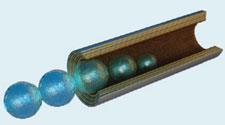A tiny little machine, a couple of dozen micrometres long, can be propelled by a jet of oxygen bubbles and controlled by a magnet

A tiny little machine, a couple of dozen micrometres long, can be propelled by a jet of oxygen bubbles and controlled by a magnet, thanks to work by an international research team. The scientists are from China, Germany, and Japan and led by Samuel Sanchez of the Leibniz Institute for Integrative Nanosciences in Dresden. The controllable devices the team have developed could find applications in everything from environmental remediation to medical diagnostics.
Nature abounds with microengines for a multitude of uses. For example cilia and microflagellae propel bacteria and are involved in processes such as hearing, while protein-based machines are used to transport materials within our cells. Sanchez and his colleagues have been inspired by this biological machinery to come up with self-powered devices on the microscopic scale.
Of course, ideally, micromachines that mimic biological systems should also exploit biological systems, such as enzymes, to power themselves. The machines should also, at the same time, retain compatibility with living things. Because of these criteria, other researchers have exploited enzymes to impel carbon nanotubes, but their systems suffer from diffusion and Brownian motion and are nudged randomly to and fro instead of staying to a direct course.
Sanchez and his colleagues hoped to counteract the situation of their machines being buffeted by Brownian motion. In earlier work, the team built a platinum catalyst based microengine that they could control using a magnetic field and direct the device carrying a payload towards a specific target. In this original device, it was the platinum metal that catalysed the decomposition of hydrogen peroxide, releasing a jet of oxygen bubbles. However, a platinum catalyst is not only expensive but brings with it biocompatibility problems. Now, the team has turned to an enzyme called catalase to release the jet power of hydrogen peroxide and propel their micromachine around.
In the new micromachine, a rolled up film of titanium and gold contains the fuel and enzyme that react together and generate oxygen bubbles at such a rate that the device is propelled across the surface of water ten times as quickly as the scientist's original platinum-based machine. The researchers also demonstrated how the device is so powerful it can even nudge tiny polystyrene beads across the surface of water.
In this new device, the catalase enzyme breaks down millions of hydrogen peroxide molecules into water and oxygen every second, which makes this one of the most efficient micromachines yet constructed. Of course, hydrogen peroxide is toxic to the body, so while the improved efficiency certainly reduces the fuel requirements, the team is now looking for non-toxic alternatives to their bubbly jet fuel.
References
- S. Sanchez, A. A. Solovev, Y. Mei and O. G. Schmidt, J. Am. Chem. Soc., 2010, DOI: 10.1021/ja104362r






No comments yet